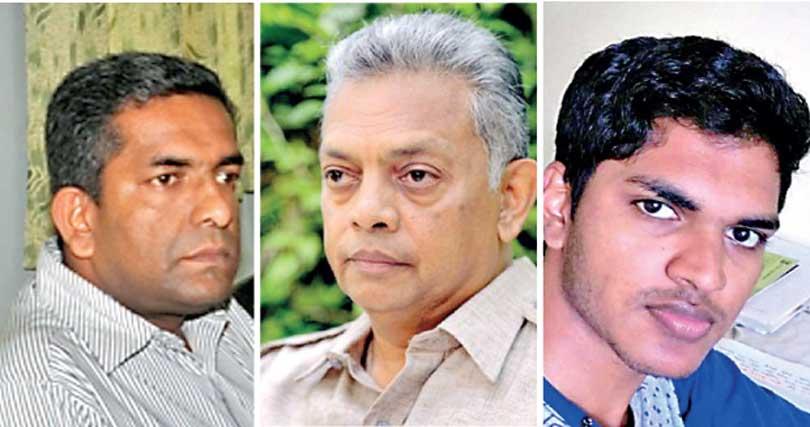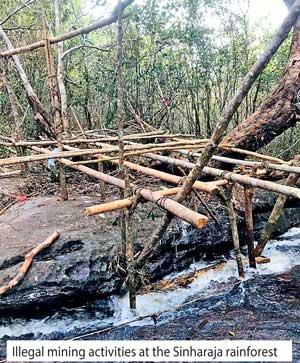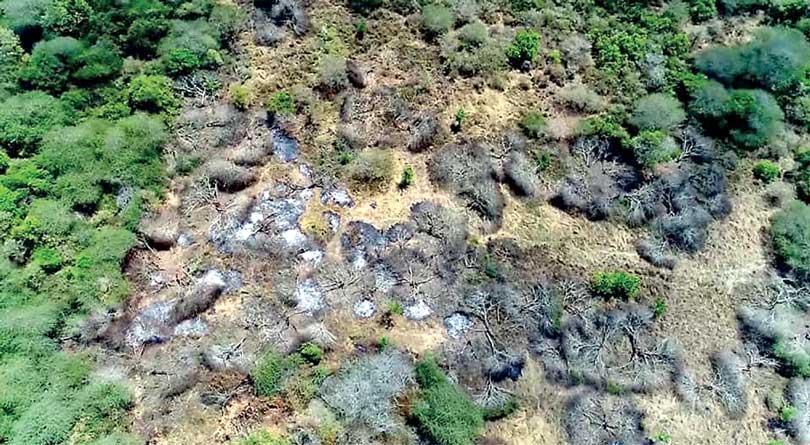30 Apr 2020 - {{hitsCtrl.values.hits}}
Large tract of state forest within Puttalam and Vanathawilluwa Divisional Secretariat which has been burnt down and cleared
 When 25-year old A.M.S.P Bandara, a Wildlife ranger attached to the Department of Wildlife Conservation (DWC) breathed his last during an encounter with poachers at Gal Oya National Park, it made people question if the issuance of weapons to Civil Defence Force officers to mitigate the human elephant conflict, has also given an opportunity for poachers to misuse weapons? Conservationists believe that with the existing curfew period, the demand for bush meat is on the rise. Apart from HEC and poaching activities, several other wildlife-related activities including continuous bush fires and sand filling in popular beaches have raised concerns among the nature loving fraternity.
When 25-year old A.M.S.P Bandara, a Wildlife ranger attached to the Department of Wildlife Conservation (DWC) breathed his last during an encounter with poachers at Gal Oya National Park, it made people question if the issuance of weapons to Civil Defence Force officers to mitigate the human elephant conflict, has also given an opportunity for poachers to misuse weapons? Conservationists believe that with the existing curfew period, the demand for bush meat is on the rise. Apart from HEC and poaching activities, several other wildlife-related activities including continuous bush fires and sand filling in popular beaches have raised concerns among the nature loving fraternity.
“When there is less human activity in national parks—i.e., lack of visitors and the presence of DWC staff within parks, there is an opportunity for poachers. The fact there is a demand for “bush meat” in the country provides the market for llegally hunted or poached wild meat. As long as there is a demand for bush meat, the opportunity for poaching exists. While DWC has increased its patrols within national parks and other protected areas, we must keep in mind that DWC is short staffed

Chandana Sooriyabandara -
Director General of DWC, Wildlife officers,
Dr. Sumith Pilapitiya - former Director General of DWC and wildlife ranger , A.M.S. P Bandara who was killed
Patrolling on the rise
According to Dr. Sumith Pilapitiya, former Director General of DWC, the curfew period and the closure of the National Parks have both a positive and negative effect on wildlife. “The positive effect is that without large numbers of visitors entering the national parks, the wildlife are not harassed while going to water, crossing the roads or even while they are resting etc. This period will give our wildlife a respite from vehicles, people and associated harassment. However, there also could be negatives to the closure of national parks. Poaching could be on the rise. But the Department of Wildlife Conservation (DWC) has staff in the field even during this period and there is absolutely no restriction of DWC staff patrolling the national parks and other protected areas. Based on my information, the DWC is using their field staff at this time exclusively for patrolling within parks. The recent incidences of the arrest of poachers are illustrative of the outcomes of increased patrolling by DWC—capture of poachers.”
Demand for bush meat
“When there is less human activity in national parks—i.e., lack of visitors and the presence of DWC staff within parks, there is an opportunity for poachers,” he added. “The fact there is a demand for “bush meat” in the country provides the market for illegally hunted or poached wild meat. As long as there is a demand for bush meat, the opportunity for poaching exists. While DWC has increased its patrols within national parks and other protected areas, we must keep in mind that DWC is short staffed, so they are unable to undertake the level of patrolling they should. Therefore, there could be some undetected poaching that goes on. At times DWC seeks the assistance of the military or STF for anti-poaching operations. But under the current situation where the military and STF have their hands full with COVID-19 management, they may not be able to assist DWC at this time. Therefore, it is quite a difficult task that the DWC is trying to do, so we should encourage them to do their best to prevent poaching.”
Bad decisions and consequences
 Speaking about the tragic death of the wildlife officer, Dr. Pilapitiya said that the source of the weapon that shot the wildlife officer is not known to him. “But regardless to the source of the weapon, the precedent created by the Minister of Wildlife of handing out guns to the Civil Defense staff to protect farmers from wildlife is unconscionable, because I think this is the first time we have seen a Minister who has been given the mandate for conserving the country’s wildlife handing out weapons to be used against wildlife. This is in clear violation of the Fauna and Flora Protection Ordinance, but more importantly, it is unethical for the Minister of Wildlife to issue weapons which we all know will be used against wildlife. Having said that, I believe that the legal framework for wildlife protection and conservation could be improved for sure. But I feel that the laws in place are adequate for anti-poaching operations and prosecuting the poachers. So I think at this point we have adequately strong laws to protect and conserve wildlife.”
Speaking about the tragic death of the wildlife officer, Dr. Pilapitiya said that the source of the weapon that shot the wildlife officer is not known to him. “But regardless to the source of the weapon, the precedent created by the Minister of Wildlife of handing out guns to the Civil Defense staff to protect farmers from wildlife is unconscionable, because I think this is the first time we have seen a Minister who has been given the mandate for conserving the country’s wildlife handing out weapons to be used against wildlife. This is in clear violation of the Fauna and Flora Protection Ordinance, but more importantly, it is unethical for the Minister of Wildlife to issue weapons which we all know will be used against wildlife. Having said that, I believe that the legal framework for wildlife protection and conservation could be improved for sure. But I feel that the laws in place are adequate for anti-poaching operations and prosecuting the poachers. So I think at this point we have adequately strong laws to protect and conserve wildlife.”
Curfew and its impact on HEC
Dr. Pilapitiya further said that there is no data showing that the Human Elephant Conflict (HEC) has increased during the period of curfew. “Based on all reports, the sector least affected by the COVID-19 related lockdown has been the agricultural sector as the Government permitted people involved in agriculture to go to work during the curfews. So it may be a perception that HEC has increased during this period. I believe that HEC is about the same now even under these conditions. However, this is not to say HEC is not a problem in the country. It is a significant problem and it is really the most significant social, political and environmental problem in the country. If people are not there to guard their fields at night during this period, there is a probability that elephants raiding their crops may have increased. With the Government’s focus on increasing agricultural production so that the country will not face a food security problem over the next few months, measures have to be taken to minimize the opportunity for elephants to raid crops. The approach taken by the Government has been to limit elephants to protected areas through electric fencing. This has not been very successful. If we are trying to protect crops and houses from elephants, should we fence the protected areas or should we fence villages and crop fields? I think that we should fence what we are trying to protect. The Center for Conservation and Research (CCR) which is led by Dr. Pritiviraj Fernando has developed a feasible solution to HEC and piloted projects of village and agricultural fences which are operating successfully in the Kurunegala, Anuradhapura, Trincomalee and Hambanthota Districts. Delegations from India, Malaysia and Myanmar have visited these pilot projects and adopted the lessons learnt in human-elephant conflict mitigation in their countries. Representatives of 13 African countries visited these pilot sites in Sri Lanka in 2017 to learn from these experiences. But it is very sad to note that our political authorities and bureaucrats are disinterested in visiting such sites and learning from the experiences of these successful projects, and instead stay mired in tried and failed approaches.”
Cabinet approval sought to increase compensation
However, according to Chandana Sooriyabandara, Director General of DWC, wildlife officers have been allocated compensation through the Wildlife Association Fund. “But we have sought cabinet approval to increase the amount to Rs. 2 million and we are hopeful that the Minister would pass it. This incident got highlighted because the officer passed away but there’s another ranger whose leg has been amputated but nobody talks about their service. There are others who have been injured too.”
When asked if this was the first time a ranger died in an encounter with poachers Mr. Sooriyabandara recalled an incident that had happened 15 years ago where a ranger at Yala National Park was killed. “There were two other incidents as well. But close to 30 rangers and wildlife officers have died due to elephant attacks, terrorist activities during the war and other reasons.”
He further alleged that the poachers at the Gal Oya National Park have used a weapon that was issued to a civil Defence force officer. “But most of the time poachers use illegal weapons or they misuse weapons given for official purposes. With the curfew, the encounter rate has increased. Most of the time, wildlife officers are involved in tourism-related activities. Therefore, a ranger, ranger assistant, wildlife guard and 10 others are stationed at all national parks. As a result a significant number from the cadre is on duty and have limited time for patrolling. When researchers visit we have to send an officer with them. Sometimes there are District level meetings that they have to attend. Therefore they had limited time to engage in law enforcement activities. But with the existing curfew they have more time to go on patrols and therefore the encounter rate has increased.”

Large tract of state forest within Puttalam and Vanathawilluwa Divisional Secretariat which has been burnt down and cleared
A call for justice
In a statement issued by the Wildlife and Nature Protection Society, it urged the due process to be done and the poaches brought to justice along with the appropriate legal action be dispensed immediately. It further read that whilst this is not the first incident where a Ranger has been shot dead or injured badly in the recent past, the DWC must re-look at its process of ranger training to determine what they currently have in its process is sufficient to all its rangers that go on such raids. “It is made to understand that this gentleman had only joined the DWC six months back and if this true, the question does arise whether he was provided the required training and time to go on such raids. We condole with the family of Ranger Bandara."
(Pix Rainforest Protectors Sri Lanka)
25 Nov 2024 43 minute ago
25 Nov 2024 2 hours ago
25 Nov 2024 2 hours ago
25 Nov 2024 3 hours ago
25 Nov 2024 3 hours ago